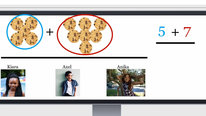- Cynthia Stenger
- Professor of Mathematics, Chair
- Presenter’s NSFRESOURCECENTERS
- University of North Alabama
- Jayson Jackson
- Mathematics Instructor
- Presenter’s NSFRESOURCECENTERS
- University of North Alabama
CPR^2
ED MSP Award #: 000669059
2015 (see original presentation & discussion)
Grades 9-12
Our collaborative partnership between University professors and Middle and High School teachers and their students supports the integration of computer programming into the high school classroom. In professional development sessions and classroom modeling, teachers learn to use computer programming to teach generalization and abstraction. In a two-week content intensive summer institute, teachers use programming to improve their ability to construct logical arguments and learn to apply this instructional treatment in their classrooms.
Mathematics, Computer Science, Integrating STEM and CS
Department of Education (ED)
Related Content for CPR^2
-
 2021Computer Science integrated with Mathematics in MS
2021Computer Science integrated with Mathematics in MS
Jessica Smith
-
 2017E4Tech: Engaging, Exciting and Empowering Educators
2017E4Tech: Engaging, Exciting and Empowering Educators
Lisa Chambers
-
 2017Making Math Fun with Robotics
2017Making Math Fun with Robotics
Harry Cheng
-
 2020Creating industry-informed, integrated STEM career pathways
2020Creating industry-informed, integrated STEM career pathways
Jackie DeLisi
-
 2021Connecting Math and Science through Decoding Models
2021Connecting Math and Science through Decoding Models
Aditi Wagh
-
 2019Computing with R for Mathematical Modeling
2019Computing with R for Mathematical Modeling
Jie Chao
-
 2016Introduction to Data Science: Thinking Critically About Data
2016Introduction to Data Science: Thinking Critically About Data
LeeAnn Trusela
-
 2021Wearable Learning Cloud Platform (WLCP)
2021Wearable Learning Cloud Platform (WLCP)
IVON ARROYO
This video has had approximately 466 visits by 362 visitors from 74 unique locations. It has been played 272 times as of 05/2023.
Map reflects activity with this presentation from the 2015 Teaching & Learning Video Showcase website, as well as the STEM For All Multiplex website. 
Based on periodically updated Google Analytics data. This is intended to show usage trends but may not capture all activity from every visitor.
show more
Discussion from the 2015 Teaching & Learning Video Showcase (9 posts)


Jacqueline Blake
This is so true. Love the video.
Joni Falk
Co-Director
Interesting that programming is seen as a general way to move students towards generalization and abstract reasoning. Teaching programming seems to be a challenge for some of the middle school teachers. Do they then teach programming to their students and does this change the general way that they teach math and science? How do you measure impact on teachers and on students? Very interesting video, thanks!
James Jerkins
The primary goal is teaching generalization and abstraction. We’ve found that experimentation with simple computer programs induces the students to develop the desired mental frameworks. Find out more at www.cpr2.org
Kevin Brown
Senior Research Scientist
The rocketry video at the beginning really captured by interest! Can you explain how that is an example of teaching students to generalize using computational thinking? It must be very difficult to assess changes in abstract reasoning. Have you been able to demonstrate an impact on student learning?
James Jerkins
The rocket launch is part of our lesson on projectile motion. We use rockets like the one shown in the video and smaller air powered rockets.
We have evidence to show improvement in abstraction and generalization during our Summer Institute and STEM camps. See our research section on www.cpr2.org for details.
Rosalind WestHarris
Excellent video. Looks like a real learning and teaching tool.
Cynthia Stenger
Professor of Mathematics, Chair
Thanks for your comment and questions! We measure student and teacher progress by collecting responses throughout the instruction. Then we use APOS analysis to determine what level of mathematical thinking, action, process or object, is being demonstrated for each mathematical concept. We look at participants responses over time and record progress or digress through the levels.
Cynthia Stenger
Professor of Mathematics, Chair
The rocket launch is part of our lesson on functional behavior. Specifically, we are examining the characteristics of a downward facing parabola. The instructional treatment seeks to push learners to develop mental frameworks or images for a particular math concept, through engaging them in writing programs to explore essential characteristics associated with the concept. We feel that describing these characteristics in mathematical language is an important step.We also guide learners to make conjectures and develop logical arguments about the relationships between concepts. Finally, we engage in activities, e.g., a rocket launch, that apply the concept in order to give participants the opportunity to interiorize the conceptual process.
Deborah Kariuki
Computer Science Teacher
Programming is a natural marriage with math. It seems that if you have teachers who already understand math and computer science you can do wonderful things in learning math. Computer Science is one area that currently is a high need for many school districts. What does it take to train the teachers to become well versed in computer science as to then use it to write material that utilizes this knowledge in math. Do you have data that shows how students retentionl is measured? I come back to the fact of what happens to teachers who want to use this system but they do not have access to computers for thier math classes? I would like to be part of these math classess all the same because they are very interesting.
Further posting is closed as the event has ended.